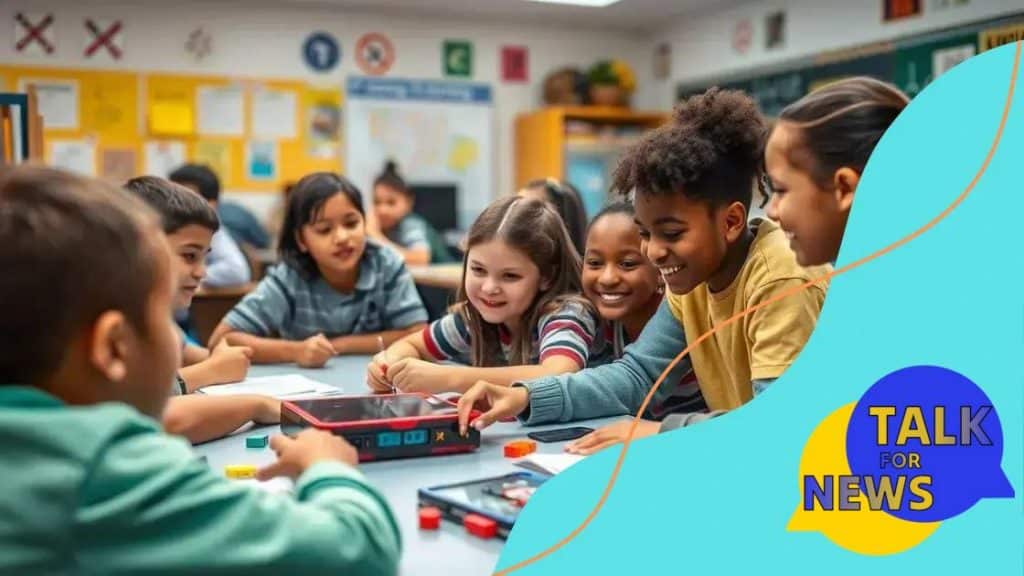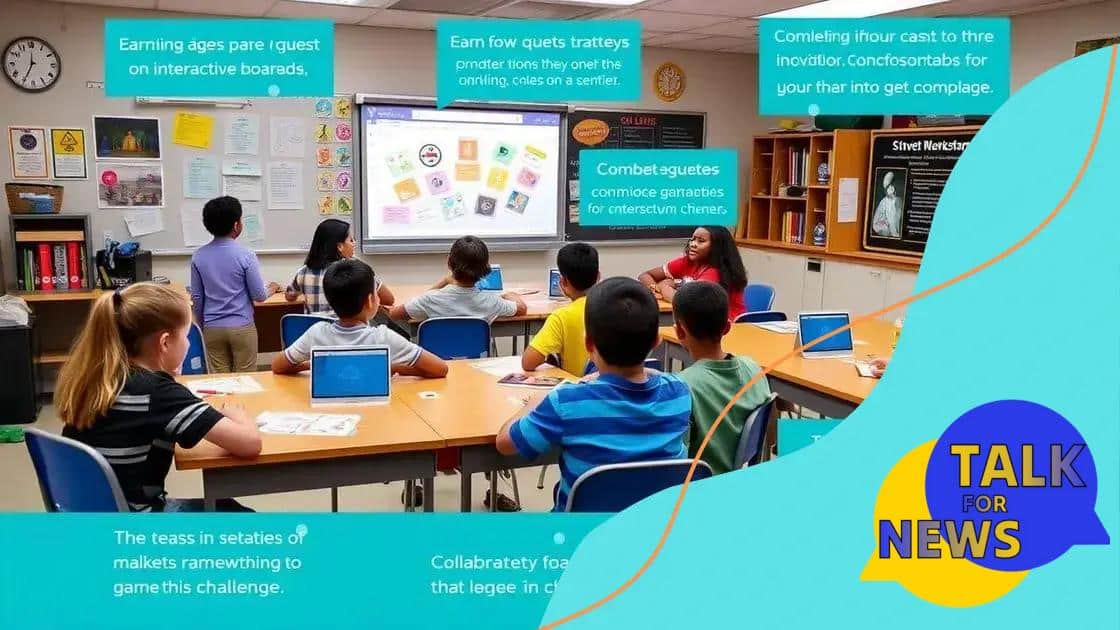Gamification’s role in increasing student engagement

Anúncios
Gamification’s role in increasing student engagement involves using game elements like rewards and challenges to enhance motivation and participation in educational settings.
Gamification’s role in increasing student engagement is transforming how students interact with learning. Picture classrooms where students are not just passive listeners but active participants. Isn’t that a refreshing change?
Anúncios
Understanding gamification in education
Understanding gamification in education means recognizing how game-like elements can enhance learning experiences. This approach is not just about adding fun; it fundamentally changes how students engage with content.
Gamification taps into students’ natural desires for challenge and achievement. By incorporating elements like points, badges, and leaderboards, educators can make learning more interactive. This approach encourages students to take an active role in their education.
Key Elements of Gamification
Anúncios
When considering gamification, it’s important to understand its core components:
- Goals: Clear objectives give students direction.
- Feedback: Immediate responses help students know how they are progressing.
- Rewards: Incentives motivate students to strive for more.
These elements create a framework that engages students on multiple levels. For instance, setting achievable goals can increase their motivation. Feedback can also be incredibly powerful, as it helps learners understand their strengths and areas for improvement.
Furthermore, gamification allows students to collaborate and compete in a positive way. It creates an environment where learning becomes a shared journey. When students see their peers participating, they are often inspired to engage as well.
Benefits of Gamification in Education
There are numerous benefits to applying gamification in the classroom. Here are a few notable ones:
- Increased Engagement: Students are more likely to participate when the material feels game-like.
- Enhanced Retention: Learning through play can improve memory retention.
- Better Collaboration: Group activities foster teamwork and problem-solving skills.
As students become more engaged, their overall learning experience improves. They start to see learning as a fun and rewarding process, rather than a chore. This shift in perspective can lead to better academic outcomes.
Benefits of gamification for student motivation
The benefits of gamification for student motivation are truly remarkable. By incorporating game elements into lessons, teachers can spark enthusiasm and engagement among students. This innovative approach helps create an interactive learning environment that encourages participation.
When students experience gamified lessons, they are presented with challenges that not only hold their attention but also inspire them to strive for success. The sense of accomplishment that comes from achieving goals keeps learners motivated. Essential aspects of gamification, such as rewards and competitions, further enhance this motivation.
Key Motivational Benefits
Here are some notable benefits of gamification:
- Increased Engagement: Students are more likely to participate when lessons feel like games.
- Immediate Feedback: Instant responses allow students to see their progress quickly.
- Incentives: Badges, points, and rewards encourage continuous effort and improvement.
Gamification promotes a healthy competitive spirit among students. When they are faced with friendly challenges, they often seek to outperform their peers. This not only boosts individual motivation but also fosters a sense of community within the classroom.
Moreover, gamification can cater to diverse learning styles. Visual learners can benefit from graphics and levels, while auditory learners may prefer sound effects and music that accompany game elements. Engaging students in personalized ways boosts their drive to succeed.
Improved Learning Outcomes
As motivation increases, so does the likelihood of better academic performance. Gamified activities stimulate critical thinking and problem-solving skills. These are invaluable not just in school but in real-life situations as well. Students often find themselves more invested in their education when lessons are dynamic and interactive. Ultimately, this makes learning not just a task, but an exciting adventure.
Examples of effective gamification strategies

Examples of effective gamification strategies can greatly enhance the learning experience. By integrating playful elements into lessons, teachers not only make education more engaging but also foster a deeper connection with the material.
One common strategy involves using points and levels. For instance, students can earn points for participation and completing assignments. As they accumulate points, they progress through levels, which introduces an engaging challenge to their learning journey.
Incorporating Challenges
One effective approach to gamification is introducing challenges or quests. These tasks require students to solve problems or complete specific objectives. Quests can range from simple exercises to complex group projects. When students take part in these challenges, they often collaborate and motivate each other. Here are some benefits:
- Teamwork: Students often work together to achieve a common goal.
- Critical Thinking: Challenges encourage students to think creatively.
- Fun Learning: The quest format adds excitement to the learning process.
Integrating these elements creates an inviting atmosphere for the students. Instead of viewing tasks as obligations, they start seeing them as exciting challenges.
Implementing Badges and Recognition
Another popular gamification strategy is to use badges and rewards. When students achieve specific milestones or demonstrate particular skills, they earn badges. This recognition can serve as both a motivator and a source of pride. Badges can be displayed digitally or physically, giving students a tangible reminder of their accomplishments.
The idea of earning something for their efforts drives students to engage more deeply. It encourages a culture of achievement, where students celebrate each other’s successes, too. Gamification strategies like this are powerful in shifting the focus from solely passing tests to embracing the entire learning experience.
Lastly, incorporating digital platforms can enhance these strategies. Many educational apps offer gamified features that track student progress, create leaderboards, and facilitate friendly competition. This added technology can further engage students and encourage them to take charge of their learning path.
How to implement gamification in classrooms
Implementing gamification in classrooms can be an exciting way to engage students and improve their learning experiences. By using game-like elements, teachers can create an interactive environment that motivates students to participate actively.
One of the first steps in implementing gamification is to define your learning goals. What specific outcomes do you want to achieve? Once you have a clear understanding of these goals, you can design activities that align with them. Consider what elements can make learning fun while still meeting educational objectives.
Choose the Right Tools
Next, choose the right tools for your gamification strategy. There are numerous apps and platforms available that can help incorporate gamified features. These tools often include options for tracking progress and providing instant feedback. For example, platforms like Kahoot! and ClassDojo allow teachers to create quizzes and rewards systems easily.
The adaptability of many online tools means you can customize them to suit your specific lesson plans. This personalization can make lessons even more engaging.
Design Engaging Challenges
Creating engaging challenges is crucial. Students love problem-solving, especially when presented in a fun way. Design activities that involve teamwork, friendly competition, and unique tasks. Quests or challenges can motivate students to dive deeper into the subject matter.
- Use Levels: Introduce different levels of difficulty to cater to students’ various skill levels.
- Incorporate Storytelling: Create narratives around assignments to make them more relatable and exciting.
- Offer Rewards: Recognition through badges and prizes can motivate students to achieve their goals.
Encouraging a classroom culture of appreciation can also enhance the experience. When students celebrate achievements, big or small, it fosters a supportive learning environment.
Finally, don’t forget to collect feedback from your students. This feedback can provide valuable insights into what strategies are most effective. Modify your approach based on their input to keep the learning experience fresh and engaging.
Challenges and limitations of gamification
While gamification offers many advantages, there are also challenges and limitations to consider in educational settings. Understanding these potential drawbacks is crucial for effectively implementing gamification in classrooms.
One significant challenge is ensuring that the game elements do not overshadow the actual learning objectives. It’s essential to design gamified activities that align closely with educational goals. If students focus too much on earning points or badges, they might miss the core concepts of the lesson.
Balancing Engagement and Learning
It can be difficult to strike the right balance between engagement and true educational value. Some students may get too caught up in competition, which can lead to stress rather than enjoyment of the learning experience. Teachers must monitor students’ motivations to make sure they stay engaged for the right reasons.
Another limitation of gamification is the potential for unequal participation. Not all students may respond positively to game-based learning methods. Some might feel discouraged if they do not succeed or if they struggle with the competitive aspects. It’s essential to find ways to include all learners, ensuring that everyone feels valued and can contribute.
Resource Allocation and Training
Implementing gamification can also require additional resources and training. Teachers may need to spend time creating digital content and activities, which can be overwhelming. Furthermore, they may require training to understand how to effectively use gamification tools. This may not always be possible, especially in underfunded schools.
Additionally, it is essential to assess whether gamified strategies truly enhance learning outcomes. Teachers and schools need to analyze the effectiveness of their methods continually. If specific strategies do not yield the desired results, they must be open to adjusting their approach and exploring other teaching methods.
Ultimately, recognizing these challenges and limitations helps educators prepare for a more balanced implementation of gamification. With careful planning and adaptation, the benefits can often outweigh the drawbacks.
FAQ – Frequently Asked Questions about Gamification in Education
What is gamification in education?
Gamification in education uses game-like elements to engage students and enhance their learning experience.
How can gamification improve student motivation?
Gamification increases student motivation by providing rewards, feedback, and challenges that make learning more interactive and fun.
What are some examples of gamification strategies?
Examples include using points and levels, creating quests or challenges, and implementing badges for achievements.
What challenges can arise when implementing gamification?
Challenges include ensuring that game elements do not overshadow learning objectives and catering to different student needs.





